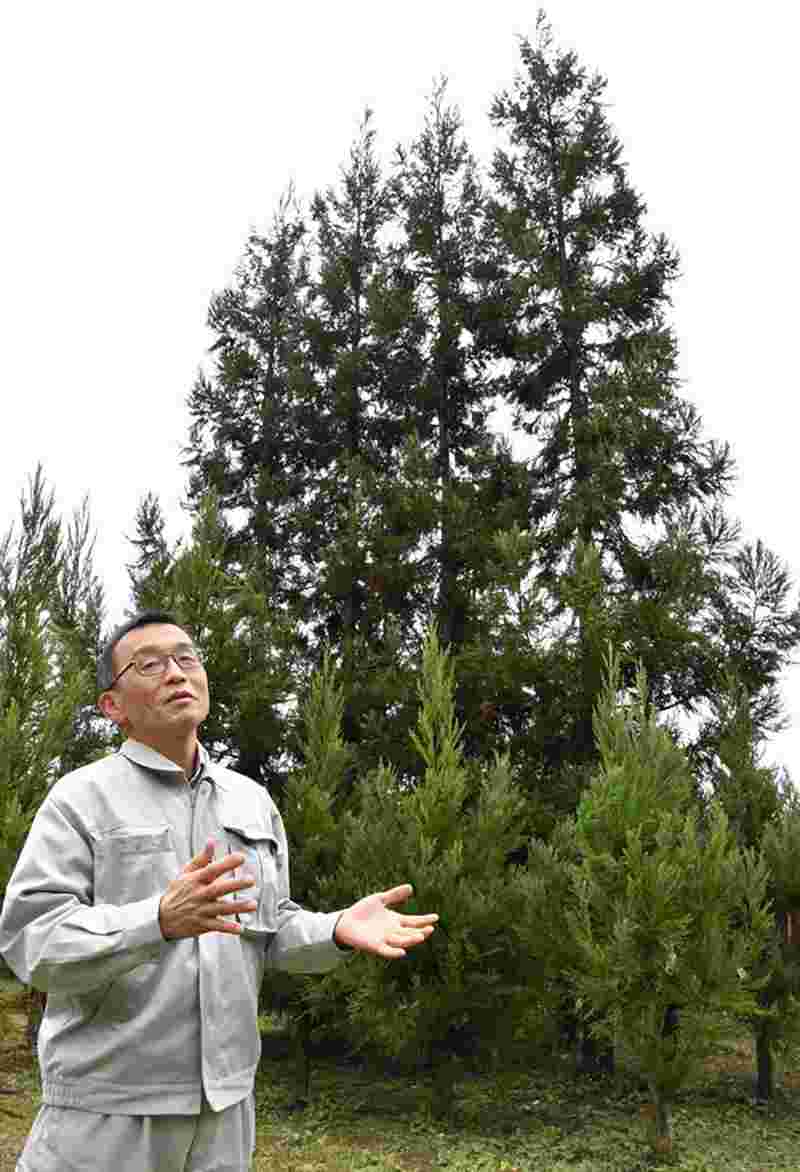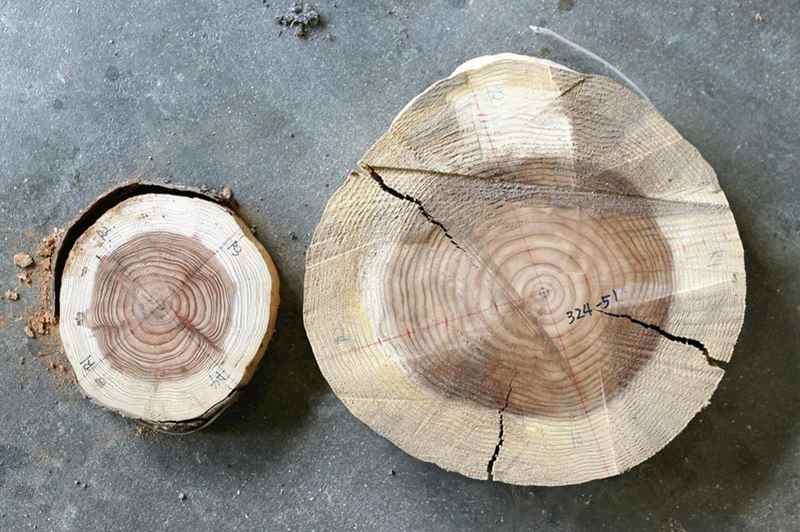
Masahiro Kubota stands in front of elite trees at the wood breeding center in Koshi, Kumamoto Prefecture, on Dec. 3.
12:02 JST, January 10, 2022
SAGA — The government is trying to promote a new variety of Japan cedar that grows 1.5 times faster than conventional cedar and produces less pollen.
The new cedar variety, called “elite trees,” is expected to lead to increased production and reduce the burden on forestry workers, a sector chronically short of human resources.
The elite tree is an artificial cross of the elite Japan cedar, which has excellent growth rate. Shipments of elite seedlings will begin in Kyushu this spring.
While a Japan cedar usually reaches a height of 15 to 20 meters in 40 to 50 years, the new variety will reach that height in about 30 years.
“Until now, forestry workers have generally harvested the trees planted by their father’s and grandfather’s generations. The time will come when we’ll be able to harvest the trees we planted with our own hands,” said Masahiro Kubota, an official at a Kyushu-based tree breeding center.
The breeding center, a national research and development institution located in Koshi, Kumamoto Prefecture, has been searching for candidate trees in the forests of Kyushu since 1954, and has been conducting artificial breeding since around 1980.
The government intends to replace 30% of Japan cedar seedlings with elite trees by 2030 and more than 90% of them by 2050.
“We want to improve the attractiveness of the forestry industry by promoting the use of elite trees and increase production volume so that we can compete with foreign countries,” an official of the Forestry Agency said.
In Saga Prefecture, which is known for its large planted forests, new varieties of Japan cedar developed by the prefecture are scheduled to begin shipping seedlings soon.
The prefectural forestry research laboratory developed them last year after more than half a century of work.
The laboratory selected about 50 varieties from the prefecture’s forests and crossbred them to generate four varieties with particularly high growth rates. It named the new varieties “Sagan Sugi” (Sagan cedar), inspired by the local J1 soccer team, Sagan Tosu, and is applying for trademark registration.

Trunk cross sections of Sagan Sugi, right, and conventional Japan cedar planted at the same time are seen at the Saga prefectural forestry laboratory in Saga.
Like the elite tree, the Sagan Sugi variety grows faster and has less than half of the usual pollen dispersal. It’s also 1.5 times stronger than conventional Japan cedar. The Saga prefectural government is trumpeting these three major advantages to the public.
The seedlings are expected to be planted in the mountains and forests in Saga Prefecture this spring.
These new varieties can also lighten the burden on forestry workers.
Foresters have to cut away underbrush once a year for about five years after planting because the seedlings will not grow healthily if they are covered with such foliage. However, working in the summer can lead to heat stroke, and wasp bites are common.
With the new faster-growing varieties, the time required for forest floor cleaning can be reduced to about three years, leading to a cost reduction of about ¥200,000 per hectare.
“As the cedar varieties are suited to the soil and weather of Saga, they can be improved, reflecting the needs of producers,” said Atsushi Ejima, a researcher at the laboratory.
“We’ll convey their advantages, because we can only say that it’s a success if it becomes widespread.”
Serious worker shortage
According to the Forestry Agency, the number of forestry workers nationwide was about 45,000 in 2015, about a third of the number in 1980. This is because there is a shortage of workers due to the aging of the population, and the heavy workload makes the jobs unattractive.
Although mechanization has improved work efficiency, there is still a serious shortage of workers.
Another reason for the declining number of forestry workers is that domestic lumber sales have been declining due to the availability of cheap imported lumber with a stable supply. However, domestic sales have been recovering in recent years, as cedar and other trees planted in large numbers after World War II have come into use.
The “wood shock,” a global surge in lumber prices, continues to provide a tailwind for the domestic lumber industry.
"Politics" POPULAR ARTICLE
-

Japan to Support Central Asian Logistics Route That Bypasses Russia, Plan to Be Part of Upcoming Summit in Tokyo
-

Japan to Tighten Screening of Foreigners’ Residential Status by Providing Information of Nonpayment of Taxes
-

Takaichi Cabinet Approval Holds at 72% as Voters Back Aggressive Fiscal Stimulus, Child Benefits
-

Chinese, Russian Bombers Flew Unusual Path by Heading Toward Tokyo; Move Likely Meant to Intimidate Japan
-

Takaichi Meets Many World Leaders at G20 Debut in Johannesburg; Speaks with Heads of Countries Including Italy, U.K., Germany, India
JN ACCESS RANKING
-

Keidanren Chairman Yoshinobu Tsutsui Visits Kashiwazaki-Kariwa Nuclear Power Plant; Inspects New Emergency Safety System
-

Imports of Rare Earths from China Facing Delays, May Be Caused by Deterioration of Japan-China Relations
-

University of Tokyo Professor Discusses Japanese Economic Security in Interview Ahead of Forum
-

Japan Pulls out of Vietnam Nuclear Project, Complicating Hanoi’s Power Plans
-

Govt Aims to Expand NISA Program Lineup, Abolish Age Restriction
























